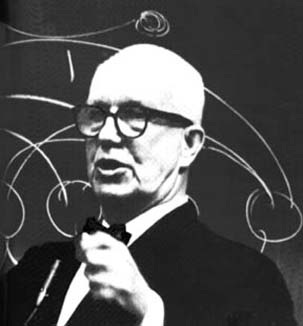


 تاريخ الرياضيات
تاريخ الرياضيات
 الرياضيات في الحضارات المختلفة
الرياضيات في الحضارات المختلفة 
 الرياضيات المتقطعة
الرياضيات المتقطعة
 الجبر
الجبر
 الهندسة
الهندسة 
 المعادلات التفاضلية و التكاملية
المعادلات التفاضلية و التكاملية 
 التحليل
التحليل
 علماء الرياضيات
علماء الرياضيات |
Read More
Date: 20-8-2017
Date: 17-8-2017
Date: 20-8-2017
|
Died: 1 July 1983 in Los Angeles, California, USA

Known as R Buckminster Fuller (or Buckie Fuller), he was famed as an engineer, mathematician and architect. Fuller's family were from New England and he grew up with a boyhood fascination for ship-building and fishing which were part of life on the coast of Maine. He [2]:-
... inherited that blend of romantic idealism and Yankee practicality which made him the spiritual heir to Benjamin Franklin and Emerson.
He married Anne Hewlett, daughter of a well-known architect, in 1917, and he served in the US Navy from 1917 to 1919. Twice expelled from Harvard University, business disasters with the construction company in which he was a minority stockholder, and the death of his four year old daughter, brought him close to suicide. Around 1927 [1]:-
He found himself stranded in Chicago, without income, alienated, dismayed, confused.
However, he decided to devote himself to proving that:-
... technology could save the World from itself, providing it is properly used .
In 1927 he designed the Dynaxion House which was intended to house the technology needed for people to live. With its wire construction it was in no way intended to be aesthetic but aimed to be a totally practical machine to live in. For many years Fuller worked on ideas for buildings, eventually arriving at the structure for which he is most famous.
He examined a vectorial system of geometry, Energetic- Synergetic geometry, based on the tetrahedron which provides maximum strength with minimum structure. This led to his patent of a geodesic dome in 1947, a building the strength of which need only increase as the log of its size [2]:-
These spherical structures, of light metal and plastic, based on great circle mathematics (whose practical application was questioned as much by some architects as their structure was by many mathematicians), were in theory without limitation of size and Fuller saw in them a universal and cheap form of shelter to cover everything from houses to cities.
Over 200,000 of such domes have been built, the most famous example being the United States pavilion at the 1967 international exhibition at Montreal.
Another of Fuller's projects, which he began in 1928, involved the design of a highly unconventional car. It was called the Dymaxion car, a three wheeled machine capable of carrying 12 passengers, of crossing fields as well as having a top speed of nearly 200 km per hour. With a manoeuvrability which allowed it to turn within its own length this was a remarkable conception and development continued until 1943. However, it was never launched as a commercial venture.
Fuller was the author of many books, including Nine chains to the Moon (1938) which was his first book. Later came No more second-hand God (1962), Utopia or oblivion (1969), and Education automation. Most famous of all is his 1969 classic Operating manual for spaceship Earth but he also published Earth, Inc. (1973), and Critical Path (1981). A collection of his writings was published in 1970 as The Buckminster Fuller reader.
Fuller was research professor at Carbondale, Southern Illinois University, from 1959 to 1968. He was appointed as Charles Eliot Norton Professor of Poetry at Harvard University in 1962. In 1968 he became a university professor at Southern Illinois University and retained this post until he retired in 1975.
Fuller was awarded many honours, including a fellowship of the Royal Institute of British Architects. This Institute awarded him their Royal Gold Medal in 1968. He also received the Gold Medal Award of the National Institute of Arts and Letters in 1968.
In [2] he is described as follows:-
One of the most controversial architectural figures of our time he produced designs for unprecedented types of structure which reflected his belief and optimism in the benefits of modern technology.
His greatest contribution, in the view of [2], may come as a surprise:-
... it may be thought, however, that Fuller's greatest contribution lay in the field of education. He was a compulsive talker and he canalized this trait into magical extempore lectures of extraordinary duration - often of up to a day or more with breaks for meals. Through these he transmitted an enthusiasm for his ideas to generation after generation of students across the world.
The assessment of Fuller given in [1] begins:-
Fuller - architect, engineer, inventor, philosopher, author, cartographer, geometrician, futurist, teacher, and poet - established a reputation as one of the most original thinkers of the second half of the 20th century. He conceived of man as a passenger in a cosmic spaceship - a passenger whose only wealth consists in energy and information.
Books:
Articles:



|
|
|
|
دراسة تحدد أفضل 4 وجبات صحية.. وأخطرها
|
|
|
|
|
|
|
قسم الشؤون الفكرية يصدر كتاب الفلسفة الغربية برؤية الشيخ مرتضى مطهري
|
|
|